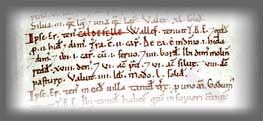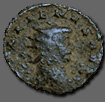Great Chalfield is recorded in the Domesday Book.
In Saxon times remote communities like Chalfield had to be self sufficient in food and water and be able to defend themselves at the manor in times of trouble. The church sat safe within the manor curtilage or compound protected by walls, mill pond or upper moat and bastions.In 1085 King William I (the Conqueror) sent men all over England to find out who owned what and how much each landowner had in land and in stock and what it was worth in order that he could extract as much tax from them as possible.

This record became known as the Domesday Book.
"Ipse.Er.ten’ Caldefelle Wallef.tenuit T.R.E. gets p.12 hid/dem’. Tra.e.ii.car.De ea.e indnio.1. hidadim’./ibs.1. car.cu’.1. feruo./iiii.borsl.lbi dim’molin redd.xviii. den’. /vi.dc pa. ./vi.ac silve./ viii.ac pasture. Valum.iiii.la. modo.L.soled."
The entry is abbreviated in latin and norman french and reads roughly as follows -
“Ernulf himself holds Caldefelle, Wallef held it in the time of King Edward and paid geld for 2 and a half hides. There is land for 2 ploughs. Of this 1 and a half hides are in demesne, and there is one plough with one slave and 4 bordars. There is half a mill rendering 18 pence and 6 acres of meadow and 6 acres of woodland and 8 acres of pasture. It was worth £4, now 50 /-.”
A translation of the Domesday entry on folio 70 of Wiltshire, re. Caldefelle (Great & Little Chalfield), states that- 'under lands of Ernulf de Hesdin who was one of the largest landowners in Wiltshire after the King, the Bishops, and various Abbeys. Chalfield was one among his twenty seven manors collectively worth £81, and formed a small part of his demesnes'.
 The key reason for choosing to settle at Great Chalfield was the fresh water spring which now feeds the fishpond. Reliable supplies of good drinking water were vital to ancient settlements. The Chalfield springs fed the Manor and later, in Victorian times, both the nearby villages of Holt and Broughton Gifford.
The key reason for choosing to settle at Great Chalfield was the fresh water spring which now feeds the fishpond. Reliable supplies of good drinking water were vital to ancient settlements. The Chalfield springs fed the Manor and later, in Victorian times, both the nearby villages of Holt and Broughton Gifford.
In Saxon times, a mill leat was created from the Chalfield Brook to feed a mill at Great Chalfield. The leat which is controlled by a weir and a sluice now fills the upper moat or mill pond which once protected the manor and powered a mill.
When clearing out the upper moat a Roman coin of Gallienus was discovered. His period of power was 253-268 AD which chimes in well with a known Roman Villa at Atworth just over a mile away. Occupation of the Villa was from 190 to 400AD.

Notes

Two and a half hides amount to approximately two hundred and fifty acres, the hide was a standard measure of land for tax and geld purposes. Notionally it was the amount of land which would support a free family, i.e. about a hundred acres. Two ploughs would each have had a team of eight oxen taking turns in pairs.
Lands in demesne were held for the lord’s personal benefit, household(s) and enjoyment rather than being granted to his men or peasants.A bordar was a cottager who often lived in a wooden hut. He was of lower status than a villager.
The water mill was used to grind corn for flour and bread, and the corn was grown on the arable land ploughed by oxen. The mill was fed by an ancient leat or canal about 900 yards long. The mill at Great Chalfield was worth 18 pence or 1/6d (7½p in today’s money); a large mill rendered up to six shillings (four times this value).
The silver penny was the only coin in circulation in the eleventh century; 240 pennies or denarii were struck from one pound of silver.Meadowland could be flooded and grew hay cut to feed the oxen, horses and sheep.
Pasture was used for grazing animals, especially sheep and cattle.